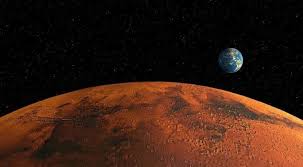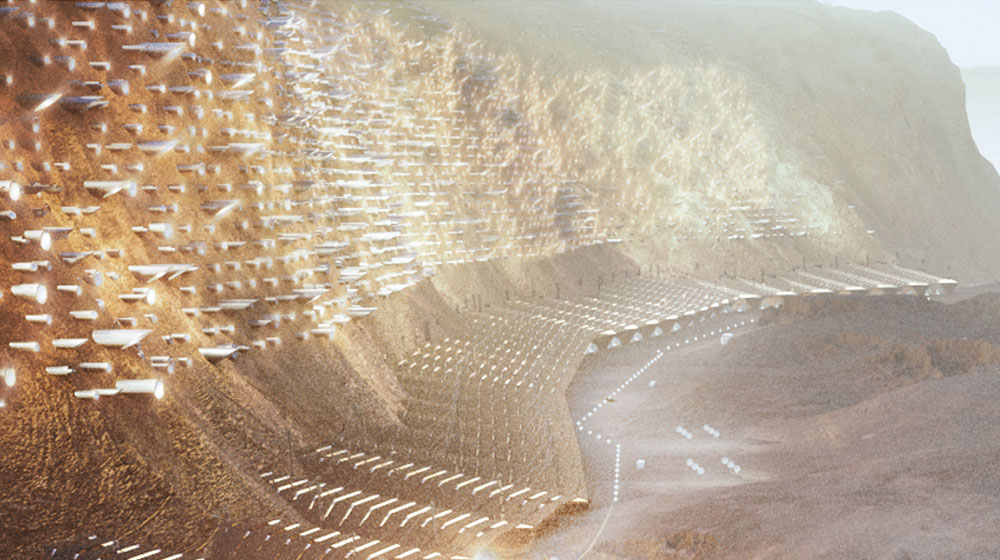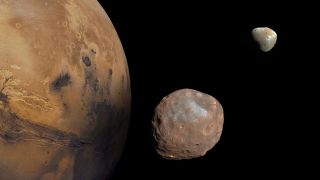The Martian moon system has never been used for
time observations before. In this new system being proposed here, the movements
of one of the Martian moons is used to create a new calendar for future
colonies on the red planet, colonies that might eventually morphe into
5 distinct city civilizations represented by the
5 Great Mountains of Mars: Olympus Mons, Ascraeus Mons, Arsia Mons, Pavonis
Mons, Elysium Mons.* One interesting 5 city proposal has been made by ABIBOO
and SONet, and has a capital called Nuwa.
It takes Mars 668 Sols*, or Martian days,
to circle the sun, almost twice as long as on Earth. In this Nerio
Martian calendar these 668 Sol days are divided into five 133 sol
day seasons. Each of these 5 seasons are in turn broken down into 5 sections,
each of which is further divided into five 5 "day"(sol) periods. (The 5
season format is one also utilized in the earthly version of the 5 Mt Calendar
system.) This 5 Mt Lunar Calendar for Mars* being proposed here is mainly
based on the cycles of the Martian moon Deimos which has a 5.32 sol period.
The Roman god Mars was originally an archetype of farmers, not wariors
like the Greek Aries. He ruled the thunder that brought rain and all agricultural
endeavors. It is an acceptable name for a colonized and peaceful red planet
where the production of food and shelter will take early precedent.
The generally used names of the two moons of Mars, however, are less acceptable.
They were discovered by Asaph Hall in August of 1877 and their names
of Deimos and Phobos were suggested by Henry Madam (1838-1901), from a
passage in the Iliad where Ares summons Fear and Fright. Such names are
not ideal for a modern peace loving society. A more appropriate name
for the two moons are Nerio and Moles, the two wives of Mars. Nerio means
strength and fortitude, Moles may mean Goddess of the mill. Hereafter the
moons of Mars will be referred to as Nerio (Deimos) and Moles (Phobus).
There are 125.5639 cycles of the Nerio (Deimos) Moon in one Martian
year of 668 Sol. These 125 cycles are divided into five equal periods for
5 Martian Seasons. Each of the five Seasons are further divided into five
parts to form 5 Martian "months"each season of 26 sols each.There are 25
of these months in a Martian year.
Each one of the 26 sol Martian "months" is further divided into 5 Martian
"weeks" of 5 days each, and each sol is divided into 5 parts of aprox 5
hours each by the movements of the other Martian moon Moles (Phobus) and
by the dual moon conjuctions and oppositions of Mar's two moons that occur
every 5 hours and 9 minutes.
(1/5 of a Sol is 4'56", 13 minutes
shy of the Phobos half cycle but close enough to visually observe moon
conjunctions for off the cuff meal scheduling.)
*(A Sol is a Martian day equally
24 hours and 37 minutes earth time, slightly longer than the earth day
of 23 hours and 56 minutes.)

Mars Time
Segmentation
5
Great Nerio Years
-
Lustrum: A Lustrum is
a quinquennial that contains 5 Years & 25 Seasons and contains 3340
Sols or Martian Days. Each series of 5 668 Sol years is ruled over by one
of the 5 Lights. This has some similarities to the Earthly Chinese System
of Stems and Branches. The series of five years are designated as FireStar,
WindStar, ZephyrStar, EarthStar and WaterStar Years. A 5 Year period
for 5 year plans and for gradual advancement from Novice to Master in any
given field. Systematic growth in the philosophy and worldview.
-
5 Years with 5 Seasons
each. Each year has 668 Sols.
-
Year 1: Listener - Initiation into the System...firsthand
experience in the program. (Titles are taken from the Manichaean
heirarchy system)
-
Year 2: Elect - expanding intellectual understanding
of the System. Study and logic.
-
Year 3: 360 - seeing the value and beauty of the
System, excelling in a given field of choice.
-
Year 4: 72 - Becoming grounded and solid in the
Teachings, instructing others, organizing Enclaves.
-
Year 5: 12 fold Master, in the flow, avoiding
pitfals and deviations that deteriate the Teaching, preserving the Tradition.
-
25 Seasons of aprox
133 sols each.
The Nerio
Year
-
1 Year: A Year contains
5 Seasons & 25 Fortnights Five 133 day seasons, pluse 3 sols,
make up the 668 Sol of the Mars Year.
-
5 Seasons
with 5 fortnights (1/2 moon phases) each of 133 aproximate sols.
5 Seasons of advancement up the Tree
of Life over a one year time span. The series of five Seasons
are designated as Bon, Nag, Man, Zen & Naz Seasons.
-
Bon Season 1:
-
Nag Season 2:
-
Mani Season 3:
-
Zen Season 4:
-
Naz Season 5:
-
25 Fortnights
(A Martian "fortnight" or "month" is five Nerio (Deimos)
moon cycles)
5
Great Nerio Seasons
-
Seasons: Five
133 Sol seasons, plus 3 sols, make up the 668 Sol (Martian day) Mars Year.
-
5 Fortnights 5 26 sol
"months" or "fortnights" make up one 133 sol season. (A Martian "fortnight"
or "month" is five Nerio (Deimos) moon cycles
and is not a half moon cycle as on Earth)
-
Fortnight 1: Forcing oneself into the reality
or worldview (Fire), Initial struggles with a new Program.
-
Fortnight 2: Expanding understanding of that world
(Wood), Familarity with a Paths Teachings and texts.
-
Fortnight 3: Experiencing the beauty of that realm
(Zephyr), Virtues of a Path.
-
Fortnight 4: Solidifying its reality into ones
being/bones (Earth), Encorporating the Instructions.
-
Fortnight 5: Flowing with its essence whilst avoiding
areas of its decay (Water). Abiding in the Essence of a Path.
-
25 Nerio Cycles
5 Nerio
Fortnights
-
Fortnight: 26
sol "months" or "fortnights"
-
5 Pentads (5 sol) -
there are five of these per 26 sol"month", 25 per 133 day Season.
(The
extra sol is used as a fast day)
-
25 Sols or Martian Days
of 24 hour 39 minutes
5
Day Nerio Weeks
-
Pentad: (5 sol)
- there are five of these per 26 sol"month", 25 per 133 day Season.
-
5 Sols with 5 Tides
each. A Sol is 24 hour 39 minutes day divided into 5 Tides or parts of
295.8 minutes each (4.93 hours).
-
Asian Cuisine/Cypress Incense (rotated according
to Season)
-
Middle Eastern Cuisine/Juniper Incense
-
Tibetan/Indian Cuisine/Fir Incense
-
Mexican Cuisine/Pine Incense
-
Italian Cuisine/Cedar Incense
-
25 Tides of 295.8
minutes each
5
Part Days
-
Sol: A Sol contains
5 Tides & 25 Hours. A 24 hour 39 minutes period from sunrise
to sunrise divided into 5 parts of 295.8 minutes each (4.93 hours).
Mars's "Sol" (solar day) is about 2.75% longer than Earth's.
-
5 TidesTides of 295.8
minutes each (4.93 hours).
-
MorningTziphra:
First half of a 4.93 hour period beginning at dawn. Personal "career"
work.
-
AfternoonShitaya:
First half of a 4.93 hour period beginning mid day, or 4:48" after
dawn. physical chores period.
-
EveningRamsha:
Relaxation, socialization period. First half of a 4.93 hour period.
-
NightSitara:
Blue light free period and sleep. First half of a 4.93 hour period.
-
PredawnAnpia:
Deep sleep period. Dream work. First half of a 4.93 hour period.
-
25 Hours: 25
Hours (consisting of 59.16 minutes each) making up 5 Tides of Time.
-
25 "Stound", aprox
11.83 minute time periods (1/5 of any seasonal hour which itself is
1/5 of a Tide.)
5
Part Tides
-
Tide: A Tide contains
5 Hours & 25 Stounds. They begin at sunrise and last 295.8 minutes
each, a period divided into two halves and based upon a sunrise beginning
time regardless of day length or season.
-
5 Hour with 5 Stounds
each lasting 59.16" and which does not vary in length according
to daylight and dark periods.
-
Hour 1: 1st 1/5 of a 5 hour block 59.16"
-
Hour 2: 1/5 of a 5 hour block 59.16"
-
Hour 3: 1/5 of a 5 hour block 59.16"
-
Hour 4: 1/5 of a 5 hour block 59.16"
-
Hour 5: 1/5 of a 5 hour block 59.16"
-
25 Stounds: 1/5
of an hour. A 11.83 minute time period. (1/5 of any hour which itself
is 1/5 of a Tide.)

Mars Capital City of Nuwa
EARTH MARS TIME OVERLAPS
The 5 Mt Lunar Calendar for Earth and Mars are similar. Each has five
season divided into 5 "months or 1/2 months" which in turn are divided
into five weeks of either 3 or 5 days each:
|
Earth Lunar Calendar
|
Mars Nerio Lunar Calendar
|
| DAY: 23 hour
56 minutes day divided into 5 parts of 287 earth minutes each (4.78 hours) |
SOL: 24 hour
39 minutes day divided into 5 parts of 295.8 minutes each (4.93 hours).
Mars's "Sol" (solar day) is about 2.75% longer than Earth's. |
| 3 DAY WEEK:
Triday (3 day) - there are five of these per fortnight, 25 per 73 day Season.
(There are only three 5 day periods in an earth "week" compared to the
5 on Mars due to the longer Mars Year of 668 Sol.) |
5 SOL WEEK:
Pentads (5 sol) - there are five of these per 26 sol"month", 25 per 133
day Season. |
| 5 WEEK MONTH:
5 15 day Lunar Fortnights make up a 73 day season. (A Fortnight is half
an earth moon cycle) |
5 WEEK MONTH: 5
26 sol "months" make up one 133 sol season. (A Martian "fortnight"
or "month" is five Nerio (Deimos) moon cycles) |
| 5 MONTH SEASON:
Five 73 day seasons make up the 365 day Earth year. |
5 MONTH SEASON:
Five 133 day seasons, pluse 3 sols, make up the 668 day Mars Year. |
25 MARTIAN
FASTS
An important facet of any valuable calendar system observed by humans
is the incorportation of set fasting periods, followed by feasting. The
human body has evolved with an absolute need for daily and extended fasting
periods for cleansing and rejuvenation and a following feasting period
when stem cells are renewed . In times of abundance it is difficult to
include extended fasting periods without set times institutionalized
by some sort of liturgical or agreed upon calendar. Hence this proposal.
As in the 5 Mt Earth Calendar, the 5 Mt Mars calendar restricts eating
to 2/5 of the sol or day, a roughly 10 hour period that corresponds well
to the 10 hr and 18 minute Nerio-Moles daily conjunctions visible in the
non polar regions of Mars. The 10 hour and
18 minute eating window allows for a roughly 14 hour fasting period each
day, allowing insulen to drop and physical cleansing and rejuvenation to
occur. Deeper levels of cleansing and renewal are instigated by the longer
fasts occuring at the end of the months, seasons and year.
(Phobos orbits closer to Mars than Deimos, with
an orbital period of just 7.66 hour and periodic conjunctions with Deimos
every 10 hr and 18 minutes.)
The use of Nerio (Deimos) moon phases, with its 5.32 sol period
(slightly longer than an exact 5 day cycle), allows for these extra time
periods of .32 sol to accumulate over time and be eventually grouped into
25 fasting periods. These 25 fasts are inserted into the Mars Lunar Calendar
at the end of each Martian month, season and year. The monthly fasts are
38 hours long, the end of season fasts are 38 hours plus an additional
72 hours, which totals 110 hours. The years end fast includes the
110 hours of fasting at the end of the fifth season plus another 72 hour
fasting period which occurs just before the beginning of a new Martian
year. This 110 hour fast and the additional 72 hour fast are separated
by one meal and total 182 hours. These numerous fasting periods are observed
in the folowing manner:
-
At the end of five observings of the 5 sol "week", on the 26th sol, observe
one fasting period of 38 hours which includes the last 6 hours of the 25th
sol after the last evening meal, continues thruout the 24 hours of the
26th sol of each month, and ends 8 hours later when the normal first meal
occurs on the first sol of a new 25 sol period.
(There
are 20 of these per Martian year, four per season, with another 5 observed
in conjunction with a seasons end fast of 110 hours.)
-
At the end of each season, after five observings of the 26 day "month",
observe one fasting period of 110 hours which includes the 38 hour fast
at months end plus 72 additional hours (3 sol periods), equally almost
5 earth days, which begins in the afternoon of the 129th sol and ends mid
morning on the beginning of a new 133 Sol Season. (There
are five of these each year. with the fifth one being extended 3 extra
sol periods after a short eating break.)
-
At the end of five seasons, observe one fasting period of 182 hours
(equalls 7.58 earth days) which begins in the late afternoon of the 660th
sol of the Martian year and ends mid morning on the beginning of a new
Martian year. There are one of these per Martian year nd it includes
the 26th day of the last 26 day month of the last season, along with 3
extra sol periods added to the end of the last season, plus 3 extra sols
added to the end of the year -- divided into two parts of 110 hours plus
another 72 hours (for a total of 182 hours with one meal in the middle.)
** Lunar calendars have a long
history among earthlings. One found at Warren Field in Scotland has
been dated to c. 8000 BC. Some scholars argue for lunar calendars existing
even earlier, such as the one from around 17,000 years ago found in a cave
painting at Lascaux and another around 27,000 years ago on a bone
baton. Scholars have argued that regular observations of the Moon go back
in the Upper Palaeolithic, with the earliest uses of the Moon as a time-measuring
device back to 28,000–30,000 years ago.
This Mars Lunar Calendar was created
by me, Yesai, on Earth on Aug 13,2021 as a means to coordinate the Earthly
5 Mt time system with the lunar phases of Mars.



